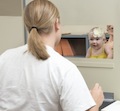Study Finds Babies Begin to Classify Faces by Gender at an Early Age
Posted on Sep 18, 2012 | Comments 0
 A new study funded by a grant from the National Institutes of Health finds that infants as young as three months begin to classify facial images by race and gender and show a preference for those that they see most often in their daily lives. The results show that by nine months, infants have difficulty recognizing the faces of people from less familiar groups.
A new study funded by a grant from the National Institutes of Health finds that infants as young as three months begin to classify facial images by race and gender and show a preference for those that they see most often in their daily lives. The results show that by nine months, infants have difficulty recognizing the faces of people from less familiar groups.
One of the researchers on the project, Paul Quinn a professor of sociology at the University of Delaware, stated: “It seems that, as time goes on during the infancy period, and we experience some categories more frequently than others, we begin to process those categories differentially.” The researchers initially hypothesized that babies would show a preference for female faces but the results showed that this was true only for babies whose primary caregiver was a women. Babies with male caregivers tended to prefer male faces.
The research is conducted in the laboratory by showing infants photographs of faces and measuring the time the infants studied the images. As objects become more familiar, the babies spent less time looking at them. “That process may provide the initial starting point on the pathway to adult concept formation, where information and memories are stored in our minds in categories, like folders in a file cabinet,” Professor Quinn said.
Filed Under: Research/Study








